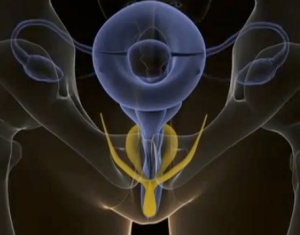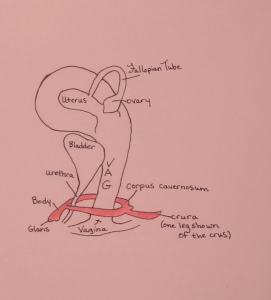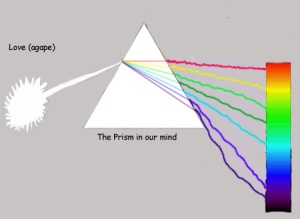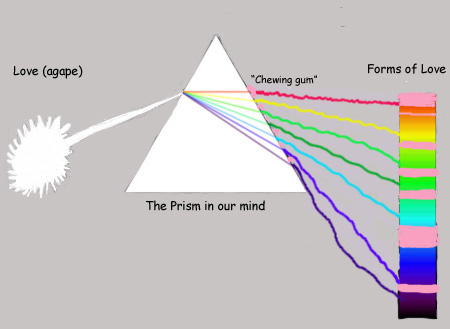ILLUSTRATED SEXUAL ANATOMY – A DIFFERENT VIEW.
Sexual science, and even society today, views sex as a pleasurable activity. It is for many, and for many, not. Perhaps this is because we put the cart before the horse. The cart is pleasure and the horse is love. Even science focuses on sexual anatomy as structures or areas that produce pleasure. Further, they refer to various proteins (neurotransmitters and receptors, enzymes and hormones) as the source of this pleasure. But, the creation of these proteins is a function of our genes and science is beginning to show our thought energy is one of the major factors in gene expression. (Genes are like switches. “Expression” simply means turning the switch on.)
This different view of sexual anatomy looks at the various anatomical structures as energy producers, a more basic approach. This is because our “thought energy” as reflected in our attitudes, along with physical stimulation, can not only express various genes, but also prevent their expression!
One of the attributes of energy is that it can be transmitted. In this different view of sexual anatomy, we will look at the major nerve pathways from the genitalia as “transmission lines” from the various “power plants” in the human body and represent them as an electrical schematic. Where previously we viewed love as some unknown energy to get a better handle on it, now we are dealing with “hard energy:” generally electrochemical energy. Most of it is specifically unknown in terms of which ion is doing what to whom, but it is recognized as energy, though some of the terminology is euphemistic, like “chemical signals.”
We will show the structures in the human body that generate this “hard energy,” the sensitive areas, and the nerve pathways by which this energy is transmitted to the brain. There may be more, but science hasn’t found them yet. For clarity, we will show the structures in one diagram, and the sensitive areas with the nerve schematic in another. I apologize for these draft sketches, for which either an artist or anatomist would shoot me, however they do convey two points: 1. The female genitalia are far more complex than male genitalia, and 2. The electrical schematic shows a possible biological mechanism for the Kundalini sexual response.

Fig1. Female Genitalia.

Fig. 2 Electrical Schematic of Female Genitalia Nerve Pathways
Pudendal nerve.
Now, you don’t have to know these nerve-names, but as long as they have them, we’ll use them. They are viewed as simply different transmission lines. The pudendal nerve pathway innervates, or serves, the clitoris and the perigenital skin.
The clitoris is the first structure. This is not an appendage, or something that is just stuck on. We only see a little of it on the outside. The nerve endings in the external clitoris are covered with Pacinian corpuscles. These are like little socks over the individual nerve endings, making them very sensitive to vibration and pressure.
The drawing above shows only about 30% of the clitoris. This is a magnificent structure and metaphorically representative of woman: there is a lot more inside than what we see on the outside.
The clitoris has roots on the inside. It splits over the urethra and has two legs, each called crus, giving it a wishbone shape. These legs insert on the anterior, or front wall of the vagina near the bottom. The internal “legs” of the clitoris not only insert on the anterior wall of the vagina, but wrap around the whole darn thing. And that is not all. Alongside each crus, or cura, are bulbs of erectile tissue. Gentlemen are familiar with erectile tissue. During the arousal phase, many women will have this erectile tissue engorged, just like men’s. Where the male’s sticks out, facilitating our entry of them, these wishbone legs may spread, opening the vagina slightly, also facilitating their entry by us. This is commonly referred to as a “wide-on,” but scientists might call it “female erection?”
(Courtesy Museum of Sex, New York, NY.)
This sketch only shows the part wrapping around the vagina. The next one shows even more of the structure, but not as complete.
(Courtesy, Museum of Sex. New York, NY.)
The penis also has about 2/3 of the structure inside. So, the average guy can now honestly claim eighteen inches. But, what really counts is the size of your love, not your love organ. The more conditions you impose on your beloved and yourself, the less love you can allow to flow through you. And it is apparently our love that transforms us. Sex alone may not do it.
In males, the pudendal nerve is associated with penile skin, scrotum and perineum (perigenital skin). We lose 50% of our penile skin on circumcision. The word “penis” comes from a word meaning “animals tail.”[1] Think of a dog. (Many women do, so it won’t be difficult.) The tail might stick straight up, or straight out as in pointing to prey, or hang between its legs. It also wags when it is happy. The word for penis in Sanskrit is “lingam,” which translates to “wand of light.” One cannot help but wonder, if the word “Lingam” was originally the “wand of enlightenment?” Or perhaps, the first “magic wand?” So, gentlemen, have a little more respect for that thing. And get a lot more respect for the yoni, or sacred place. Right now, most all of us just see pleasure and there is so much more!
Right underneath the clitoris is the opening for the urethra, or “pee hole.” This is also the orifice through which female ejaculate comes. Around the opening of the urethra (meatus) is a very sensitive area called the “U” spot.[2] It is not known if it is innervated by the pudendal nerve or not, but it would make sense. Further, this is also a sensitive area for men on the glans penis (head). It is best to point out here that all the “spots” are simply areas of greater sensitivity than the surrounding area. These are not anatomical structures and therefore cannot be surgically modified.

Fig. 3 Electrical schematic of Male Genitalia
Perigenital skin. The skin in this area is very sensitive and generally responds to light stroking, either digital or oral-lingual. The pudendal nerve ties into the sacral nerve at the base of the spine at S-2 and S-3 (second and third vertebrae in the Sacral area) and the nerve impulses are transferred up the spinal column to the brain. The term “sacral “ nerve comes from the word “sacred.” Again, in ancient Sanskrit, the word for the female genitalia is “yoni,” which means “the sacred place.” Also, this area, at the base of the spine, is the home of the Hindu “sacred life snake” named Kundalini.
The pudendal nerve enters the spine between L – 4, and 5, as well as S – 1, 2, 3 and 4. L is a designator for the Lumbar area of the spine, and S is for the Sacral area. These are being mentioned and shown for a specific reason, revealed in the next chapter.
So far, we only have three highly erogenous zones for women. We are going to wind up with 16 for women and only six for men. Are you beginning to see why women are such fantastic creatures? And this is just the beginning!
Pelvic Nerve.
The pelvic nerve innervates the perigenital skin, the vaginal barrel in front of the prostate, the cervix and the rectum. It is also believed to innervate the female prostate. Note the perigenital skin is served by two major nerve pathways: pelvic and pudendal.
The first third of the vagina seems to have a higher concentration of pelvic nerve endings than the rest of the vaginal barrel. The sensitive area through the anterior wall near the opening where the swollen tissue or glands from the female prostate protruded onto the wall, was known as the “G spot” from 1982 on, and brought a great deal of attention to our sex lives in terms of additional pleasure for women. It was thought, but not scientifically shown, to influence the “vaginal orgasm.” As sexual arousal increased, the prostate became engorged, which may increase the “size of the G spot.” The G spot is not an anatomical structure. It is the Sexologist’s term for a sensitive area where a response may be elicited when stimulated. Not all women like, or respond to this stimulation, and prefer other areas to be stimulated. The terminology of “G spot” did a great deal of good by focusing the general public’s, and science’s attention on female sexual anatomy.
Since we have mentioned the vagina, the origin of the word might be inserted here. In 1559, Matteo Realdo Colombo, an Italian anatomist, writing in De Re Atonomica, described this anatomical structure as akin to the sheath or scabbard that holds the sword, literally in Latin, vagina equals scabbard.[3] This is in keeping with the later, ancient thought that men are “penetrators.”
Female Prostate. Galen, the famous Greco-Roman physician, first described the female prostate before the year 200 AD. The female prostate is not as well defined as the male prostate. The male prostate is composed of about 10 to 20 glands and ducts, nicely packaged in the Prostatic Capsule and snuggled up next to the bladder at the back end of the urethra. The female prostate is composed of up to 100 glands and ducts, or more, around the urethra: hence the interim name, “periurethral glands.” “Pariurethral” simply means around the urethra. So, from that standpoint, the male prostate is also a “pariurethral gland.”

Figure 4. Female Prostate.
This drawing shows the arrangement of ducts common to about 10% of women. Sixty-six percent have these ducts bunched up toward the meatus and 6% have the distribution more bunched up in the center of the urethra. That percentage is based on over 200 autopsies of Caucasian women. In different parts of the world, the percentages may vary, to the point where we say that the female prostate is like the nose: they are all different, some small, some large, some with bumps and some without.
While we are here on the G spot, if you will turn the drawing on the side, face up, it is easy to see how with the standard missionary position it is easy to miss, or not fully engage this area. Various modifications of the missionary position can help alleviate this oversight. We will mention that Grafenberg, for whom the G spot was named by Dr. Whipple and Dr. John Perry, suggests rear entry, or doggie style, to fully engage the G spot.[4] When stimulating the G spot digitally, it is generally best to use two fingers, one on either side. This also picks up the insertion points of the clitoris’s legs, or cura! The pelvic nerve enters the spinal column at S-2 – S-4. This is simply between the 2nd 3rd and 4th vertebrae in the sacral region of the spine.
The pelvic nerve only innervates one area in the rectum for men. That’s four more for women totaling seven and one for men totaling four.
Hypogastric nerve.
The hypogastric nerve innervates the cervix and the uterus. The cervix opens into the vagina. While we are in the vagina—interesting thought—let’s go all the way to the top-front near the cervix. This part is called the fornix and it also has been shown to contain a sensitive area. The nerve connections are not known. It is called “the A spot.” That’s five.
On the posterior, or back wall of the vagina, there are a group of cells called the interstitial cells of Cajal.[5] These are energy producers: calcium ions. They are referred to as “electrical wave producers.” Energy! They are generally, or were first found, near the heart and in the intestinal tract. From their proximity to the heart, they are called “pacemaker cells.” Calcium ions trigger dopamine and serotonin neurotransmitters and receptors among other things. These cells are additionally stimulated by pressure, which may be sexually induced. Then we not only have nerve endings but also these little rascals producing ions, if we don’t hold them back. These are connected to some unknown nerve nexus. They are also found in the corpora cavernosum (penis “muscle”), so we have them too.[6] This gives us two more specific, but suspected areas for women, possibly innervated by the hypogastric or pelvic nerves, or both. We also have one for men.
There are now a total of four different areas (two just suspected) associated with the hypogastric nerve, some working in conjunction with other nerve pathways. So the total for women is 12. In men, the hypogastric nerve is associated with the testes and the prostate. This totals 7 areas for men and we haven’t finished with women! The hypogastric nerve has three different insertion points in the thoracic area of the spinal column at Th-10, Th-11 and Th-12. “Th” refers to the thoracic area of the spine.
We have to understand that for the past few hundred years, there has been a guy here, or a guy there, that has scientifically looked at specific parts of female sexual anatomy and physiology. But only in the past 50 years or so have these people come together, comparing notes and arguing over the “rightness” and “wrongness” of various scientific conclusions in this field. As an example, a Malaysian physician, Chua Chee Ann, discovered the “A” spot in 1993. Prof. Ali A. Shafik, from Egypt, wrote on the interstitial cells of Cajal in 2007! This is what advances science and they have a long way to go! But, many of the detrimental myths that we currently live with, now are being shattered by science.
Vagus nerve
The ladies have one more major nerve pathway in the genitalia: the Vagus nerve pathway. It innervates the cervix and the uterus. The vagus nerve doesn’t go up the spinal column. It wanders around a woman’s body, leaving a path like some women on a mall-shopping trip! “Vagus” means wanderer. Now, of course, the male vagus nerve is much more squared away. Just as our prostate is neatly packaged and squared away. We are so squared away that sometimes we could think our vagus nerve travels at right angles around our body. We are so interested in being squared away, we forgot to stop and ask for directions. You know us guys. So, our vagus nerve never got connected to our genitalia. Really, the male vagus nerve pathway pretty much follows the same path and connects to the same structures as the female, excluding the genitalia.
But, thanks to women, all is not lost! The Vagus nerve is known as the “nerve of compassion.” “In a series of controversial papers, physiological psychologist Steve Porges has made the case that the vagus nerve is the nerve of compassion, the body’s caretaking organ.”[7] Although ours is not hooked up to our genitalia, we have many other ways of showing compassion. When we compassionately say, “My heart goes out to you,” we aren’t kidding. The vagus nerve is connected to many of our anatomical structrues, including the heart. Perhaps women feel compassion more “deeply” than men simply because of this connection at the cervix.
Note that we have three major nerve pathways in the area of the cervix: pelvic, hypogastric and now the vagus nerve pathways. It is the stimulation of this area, along with the others, that creates what Dr. Barbara Keesling calls The Super Sexual Orgasm.[8] It could also be called an Optimal Blended orgasm. We have all four major nerve pathways being stimulated sending impulses to the brain. But, be careful. There are some areas around the cervix where the “skin,” or epithelial tissue, is only one cell thick! It can be easily damaged. And guys, with the woman on top, gravity pulls her cervix down, so you can save your money on Enzyte.
In her book, The Super Sexual Orgasm, she describes this orgasm as being something much more different that a vaginal orgasm and believe me it is! The likable thing about her book is that it gave exercises for women to become more comfortable with their own sexuality and with their partner. It is this comfortability with our sexuality that allows for these orgasms to occur. That brain of ours is so cluttered up with a bunch of garbage, it just automatically shuts down our pleasure no matter how much energy we are sending it. Our thoughts, even the ones we don’t know we have, do a lot of controlling in our lives and especially in our sex lives. And gentlemen, it is a part of our job to help our partner become more comfortable with her sexuality as we become more comfortable with our own. And make her comfortable with who we are.
So what is the bottom line? Women have a greater capacity for generating this electrochemical energy than men. They have at least 14 structures and areas, served by four major nerve pathways where we have 7 structures and areas served by three major nerve pathways. We exclude the hypogastric and vagus nerve connection in the uterus because the stimulation may be secondary, rather than primary. This energy, when released does work and work over time is power. That is a simple engineering definition of power. And it can be believed by some to be the power that alters our brain and body chemistry to make us better human beings, to raise us to the altitude of genius, by “building the muscles” of our consciousness.
There may be more structures in the female genitalia that are “activated” in a secondary fashion: that is not by direct contact, such as those in the uterus. The female genitalia are amazing and we have just begun the scientific journey.
One last note: the most important sex organ is the brain. All of these above won’t work as intended without the involvement of the brain and the mind! We will continue to discuss the impact of this organ as we continue. For example, the nerve endings in the uterus are not mechanically stimulated, but they work anyway.
So they have it. Power. How do we get it? It is a gift that we must be willing to receive, just as her love is a gift to us. How this is transmitted, we can only guess. It is idiopathic. (Don’t you love that word: “idiopathic?”) It is as though some of this energy escapes the unshielded parts of the nerve’s axon, or trunk and it goes through her vaginal wall onto and through the thin skin of our penis, our wand of enlightenment, enabling us and providing us with an experience, beyond our wildest dreams. Or perhaps it is excess energy from the interstitial cells of Cajal. Then again, it may simply be our own love-energy, reflecting off the polished mirror of her love. If for no other reason than this fantastic anatomy and physiology, this capacity to generate this energy and power, women deserve to be treated with much more dignity and respect than has been afforded them over the centuries. It is time for a change. Let’s hope we make it.
[1] The Story of V, Catherine Blackledge, Rutgers University Press, 2004
[2] The Naked Woman: A Study of the Female Body, Morris, D., Thomas Dunne Books, New York, NY, 2005
[3] The Story of V, Catherine Blackledge, Rutgers University Press, 2004, p.60
[4] The Role of Urethra in Female Orgasm, Ernest Gräfenberg, M.D., 1950, International Journal of Sexology
[5] Identification of a vaginal pacemaker: An immunohistochemical and morphometric study, A. Shafik, A. A. Shafik, O. El Sibai and I. A. Shafik, 2007 Journal of Obstetrics & Gynaecology Jan 2007, Vol. 27, No. 5, Pages 485-488: 485-488.
[6] Interstitial Cells of Cajal in Erectile Dysfunction, Shafik, O. El-Sibai 2006, Arch Androl 52: 255-262 Vol. 52, No. 4
[7] Born to be Good, Keltner, D., W. W. Norton & Company, 2009 p. 228
[8] The Super Sexual Orgasm, Keesling, Barbara, Harper Collins, 1997








